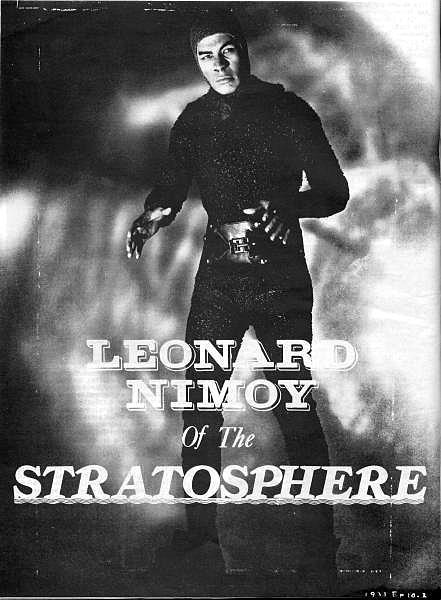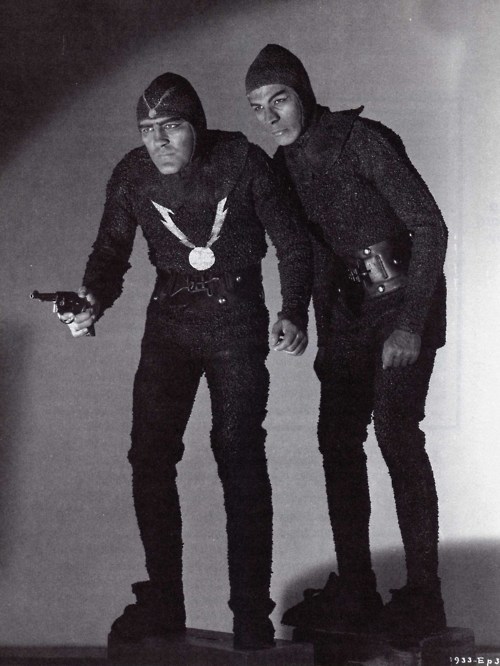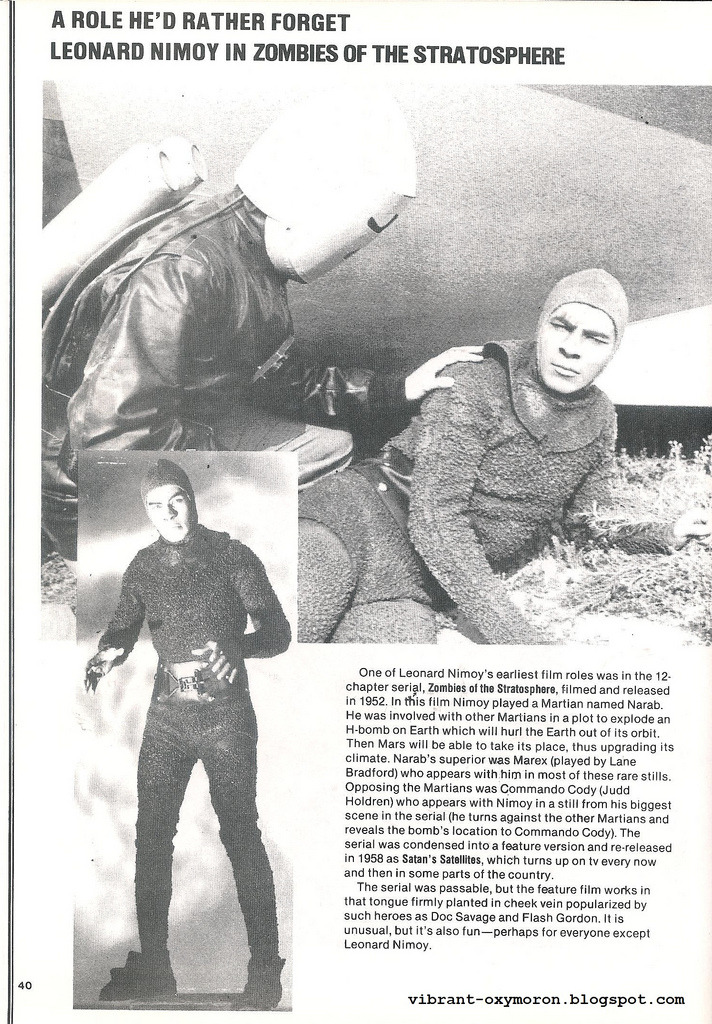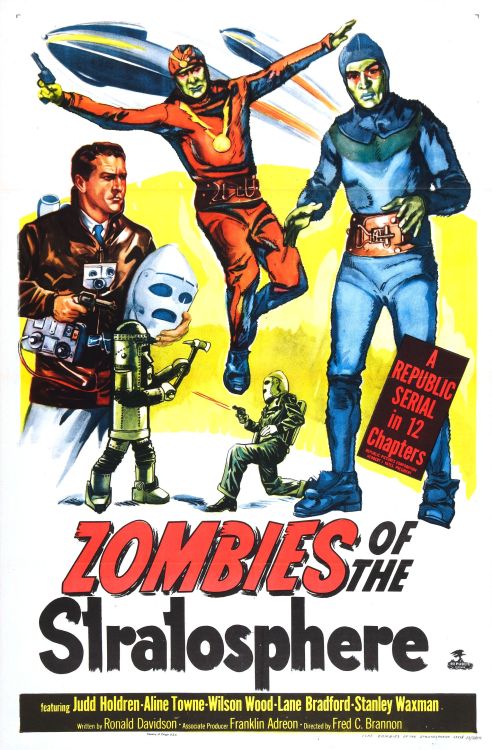Zombies of the Stratosphere
Summary by Wikipedia:
Larry Martin (Judd Holdren), a leader in the Inter-Planetary Patrol, detects a rocket coming to Earth. He takes to the air in his rocket suit and helmet to investigate and discovers two Martian invaders, Marex (Lane Bradford) and Narab (Leonard Nimoy). Since Mars is now orbiting too far from the Sun and its ecology has been dying, the Martian invaders want to swap Earth's and Mars' orbits, so Mars will then be closer to the Sun. They plan on achieving this by using hydrogen bomb plans stolen from Earth scientists to cause the two planets' orbits to swap, using specifically placed atomic explosions on both worlds.
Finding they have an Earth accomplice in the form of the traitorous Dr Harding (Stanley Waxman), the Martians set up a base in an underground cave that can only be reached from underwater. Over the course of 12 action-packed chapters, Larry, as Rocket Man, uncovers their daring plan and then their secret location and sets about defeating them. In the end the Martian plot fails thanks to the Rocket Man efforts, aided by his associates Sue Davis (Aline Towne) and Bob Wilson (Wilson Wood).
[...] The serial is remembered today as one of the first screen appearances of a young Leonard Nimoy, who plays one of the three Martian invaders, Narab. In 1958, a feature film version of this serial, retitled Satan's Satellites, was made by editing down the serial's footage to feature film length.

As always, more pictures here.
What the Internet Has to Say:
Life Before Spock: The Early Sci-Fi Roles of Leonard Nimoy – By Philip Smolen
Although serials were all the rage back in the 1930s, by 1952 the flame of popularity had gone out for this venerable type of movie. “Zombies of the Stratosphere” was one of the final attempts by Republic Pictures to re-capture their glory days. They revived the famous rocket suit from their “Commander Cody” serials and tried to spin a new 12 chapter sci-fi story around it (while still reusing a lot of old footage). The main problem is that they never bothered to update the style of the serials, so even for audiences in 1952, the movie looked old and dated. It’s really funny to watch Marex and his buddies climb out of an old Buck Rogers type of rocket ship and then get in an old Ford sedan and head on down the road! It’s even funnier to see them talk and act like typical Earth criminals and shoot revolvers. But even worse, the film is so dull, that you don’t really care what happens to the Earth by the end. The film is just one long chase after another. Larry almost buys the farm, then Bob nearly does and then Sue almost get killed.
I always felt bad for Leonard Nimoy whenever I watched this. He’s constantly climbing into the pool in the Martian’s hideout so he can enter the secret lair where all the experiments are done. Most of his screen time is spent climbing down the ladder and climbing up the ladder and doing Marex’s bidding. Nimoy has very few lines and Narab doesn’t have much characterization. But this was only Nimoy’s fifth acting credit (and his first time portraying an alien!) and at least the film presented him with a very physical role that he handled smoothly. Six years later Republic condensed “Zombies of the Stratosphere” to 70 minutes and rereleased it as “Satan’s Satellites.” Even then, the public stayed away. They knew a stinker when they saw it.
Source: http://www.roguecinema.com
What the Press Has to Say:
Flying Dic Men from Mars
[A] generation ago, Mars was the most prolific source of strange visitors from another planet. Republic Pictures Corporation, home of the best of the cliffhangers, spun a trilogy of serials about evil emissaries from the Red Planet. The Republic writers (in particular Ronald Davidson) built up a peculiarly consistent, if inexpensive, vision of Martian civilization.
Until not too long ago (so the subscript would have it), Mars was very active indeed. There was a civilization: it simply died out before we could find it. By the mid-1940s, the empire of Mars was desperately seeking sanctuary, for their world had been dying for many generations, and they didn't have much time left. Conditions had become unfavorable: low gravity, scant air pressure, yearly flooding, seasons that were dooming the planet. For each "spring," as the polar icecaps melted, the atmosphere would be fairly charged with moisture. But instead of forming clouds, the water vapor would boil away into space.
Soon, the atmosphere would no longer support life. Already, sealed cities were required for comfort. The leading scientists realized that something drastic must soon be done. But they had waited too long. They hadn't considered the effects of generations of oxygen-starvation on their brains.
(...) At this point, things must've been getting really bad on Mars, as indicated by their next attack in ZOMBIES OF THE STRATOSPHERE (1952). At least by now, they had rocketry of their own, though as might be expected, it seemed to be ripped off from earth science. But the Marsmen were now sallow-complected, staring from deep-set eyes in dark sockets (hence the title). Clearly these boys were in bad shape.
And if their appearance wasn't enough, this time their plan certainly indicated deterioration, of sense if not spectacle. As outlined by Martian leader Marex to his earthly partner, Dr. Harding, they were going to plant a super hydrogen bomb in a certain cave, and, by timing the explosion, use the detonation to blast earth out of its orbit and send it spinning off into space and (if that wasn't enough) using an identical explosion to blast Mars into earth's orbit, to take advantage of earth's climate and atmospheric conditions! (Presumably, a third blast would be needed to stop Mars once it reached the earth's orbit, but nothing was mentioned about it, and, frankly, I doubt the Martians ever though of it.)
But this time, the Opposition was fierce: agent Larry Martin, using technology created by the famous Commando Cody, led a stalwart crew in combatting this new Martian menance. The simple Flying Suit, with its atomic-fueled, sonicpowered flight jacket and simple-but-distinctive 'bullet-shaped helmet, gave Larry greater mobility than his forebears, and the pocket space ship allowed him to chase the alien invaders to their very lair.
But the Martians had an extra trick up their rubbery sleeves: a tall, man-sized robot, that, while no great shakes for looks (being somewhat like a water heater with legs and arms) seemed quite capable of damaging our heros. At one point, Larry disabled the robot, and had it taken to his lab. Imagine his surprise when it was reactivated by remote-control and began smashing up his office.
Quick work short-circuited it, and Larry was able to re-wire it for his own use when they cornered the inevitable earthly quislings at their cave-hideout. Unknown to Larry, however, there was a second cave, reached only by an underground pool. Since the Martians were able to hold their breath for long periods of time, they had been able to keep the heros form discovering it, and it was here that the H-bomb was already ticking away.
But when the Martian ship tried to flee, Larry's rocket blasted it from the skies. In his flying suit, he followed it down and learned of the cave and bomb from Narab, only survivor of the crash. Larry made it back to the bomb and disconnected the thing in the barest nick of time.
Narab survived to be sent to prison, but no more was ever heard from the planet Mars. Those in charge of watching out for Martians never saw any more, and most people forgot about the whole thing. Now we know there's nobody there. Mars is a dead issue.
Jackson, Charles L. "Flying Dic Men from Mars", Filmfax No.8, Oct/Nov 1987.





